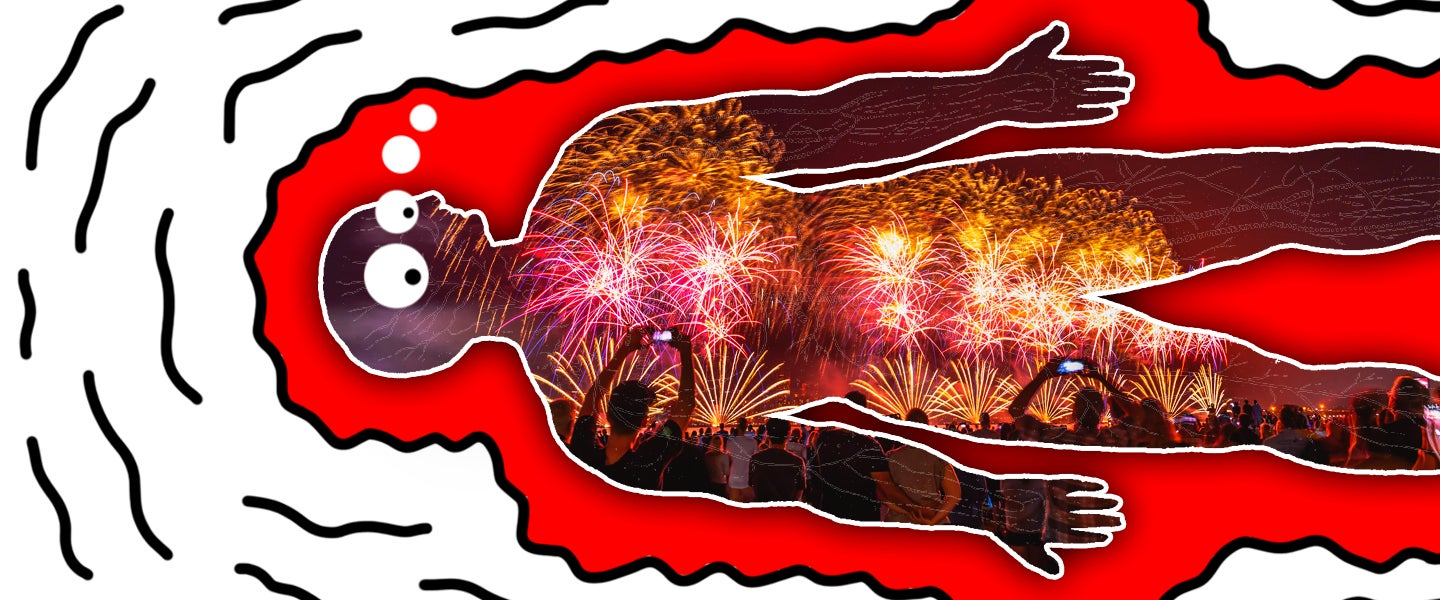The human body and fireworks: inspiring scientific works of art? Or a combustible sack of dangerous chemicals? Either way, there’s still a lot we’re learning about how the two interact — especially around the Fourth of July. Here are the most interesting things we learned about fireworks and corporeal forms over the last few months…
You Will Actually Shoot Your Eye Out
You’d think as time went on, fewer people would be injured by fireworks. But we’re all complete idiots. According to the U.S. Consumer Product Safety Commission, firework-related eye injuries nearly doubled from 2016 to 2017, jumping from 700 to 1,200. Some of the most common eye injuries include ruptured eyeballs and damaged corneas, and a large number of these injuries are happening to kids.
The main way to prevent this is to just keep fireworks to the professionals. In a home setting, you don’t even need to be the one lighting them up to get hurt: Bystanders account for 65 percent of fireworks injuries. The American Academy of Ophthalmology suggests that if you’re gonna use fireworks, everyone involved should be wearing protective eyewear, which kind of takes all the fun out of it. And no, your phone doesn’t count.
I Beg of You, Do Not Take Photos of Fireworks With Your Smartphone
Those Fumes Aren’t Good for Ya
Making bright colors explode in the air requires quite a few toxins. All the ash, soot, and metals left behind by making things go boom aren’t great for your lungs. Officials in various locations with scheduled and legal fireworks like the San Joaquin Valley in California are warning people that sensitive groups like small children, the elderly and people with respiratory conditions may experience negative effects.
In the evening hours of the Fourth of July, pollution levels skyrocket. This can be harmful for everyone, as fine particulate matter can enter the bloodstream and has been linked to heart attacks and strokes.
Fireworks Can Trigger PTSD Symptoms
Isn’t it ironic that we celebrate one of the few days of the year emphasizing patriotism by triggering veterans with Post-Traumatic Stress Disorder? The Department of Veterans Affairs estimates that between 11 and 20 percent of veterans who served in Iraq and Afghanistan returned home with PTSD. One of the many things that can cause a spike in PTSD symptoms — which can include anxiety, insomnia, and flashbacks — are loud noises. In particular, loud noises reminiscent of gunfire…i.e., fireworks. Some veterans say that the Fourth doesn’t present much of a problem in triggering their PTSD, since they expect fireworks to happen. Instead, it’s the days before and after the holiday that can surprise them. It’s a solid reminder that at the very least, you should check with your neighbors before setting off any fireworks. Don’t be an asshole.
How to Set Off Fourth of July Fireworks Without Being an Asshole to Veterans With PTSD
Sparklers Are Only Good for Disfiguring Faces
The most common fireworks-related injury is a burn, most often to arms, hands, and faces. In the month leading up to the Fourth, 280 people go to the hospital a day for fireworks-related injuries. Even in cities where fireworks are illegal, like Chicago, hospitals still witness tons of sparkler burns. The worst risk with sparklers comes from the possibility of setting your clothes on fire. Third and fourth degree burns can cause damage down to the bone, which is disfiguring for life, says Chicago-based Dr. Faran Bokhari. So maybe think twice before letting your toddler hold a sparkler.
Of Course, Most People Injured by Fireworks Are Men
Surprise! The people most likely to get hurt from fireworks are men. According to the 2017 Fireworks Report from the Consumer Product Safety Commission, 70 percent of people injured by fireworks over a one-month period from June 16th to July 16th, 2017, were men. Further, men aged 25 to 44 were injured the most, totaling 1,500 injuries, with men aged 15 to 19 totaling 1,100. The report also indicates that 12,900 people were treated in hospitals for fireworks-injuries in 2017. That means for every 100,000 people, four will be injured by fireworks. That’s an increase of two from 2008, but it’s been worse: In 1986, 6.6 people per 100,000 were injured by fireworks.

